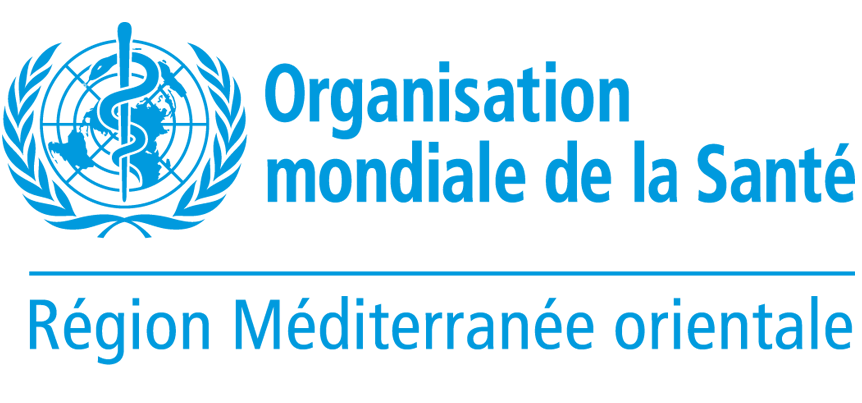Children of Yemen caught up in agony of displacement and malnutrition
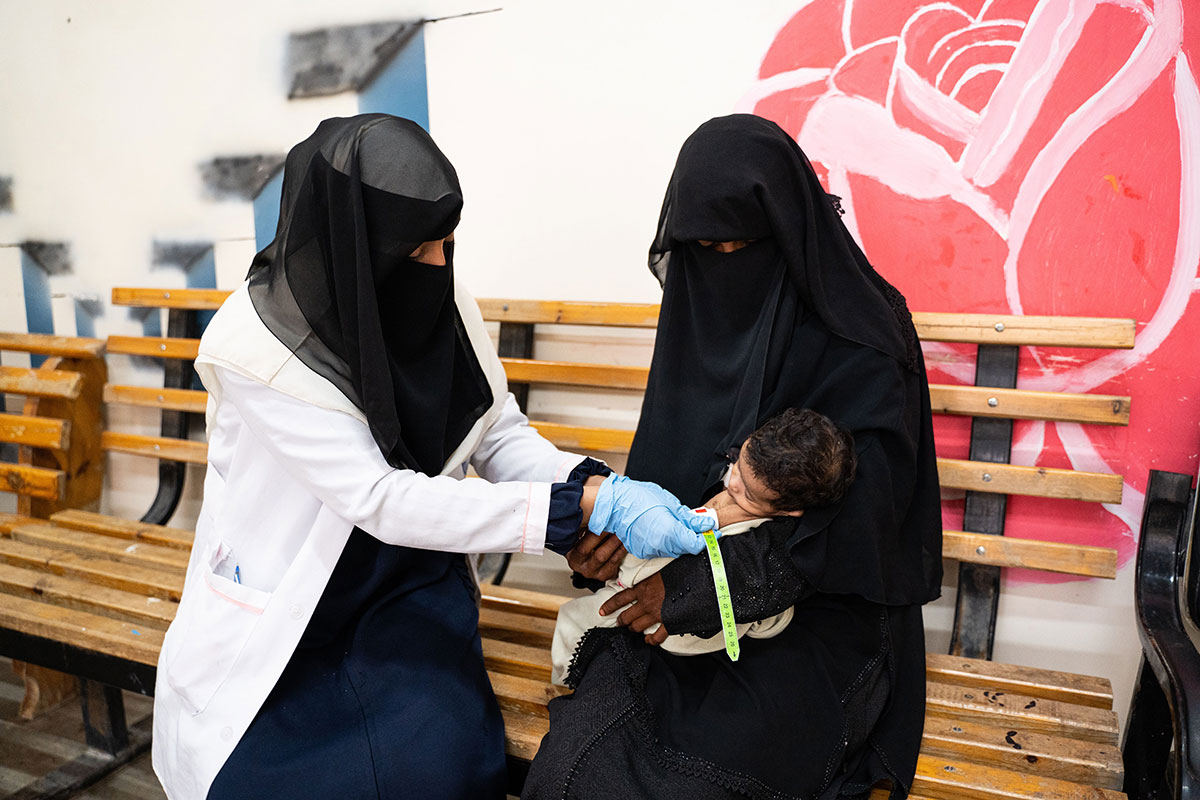 1 April 2024 – A couple of years back, a house full of life and warmth dissolved into ruins amid the conflict that was ongoing in Al Hudaydah governorate. With a heavy heart, Maisa describes the loss of her home to war: “I was once above the sky to finally have a home of my own with my little family, and now what we once had as our home turned into rubble, ripping away all the joy I once had.”
1 April 2024 – A couple of years back, a house full of life and warmth dissolved into ruins amid the conflict that was ongoing in Al Hudaydah governorate. With a heavy heart, Maisa describes the loss of her home to war: “I was once above the sky to finally have a home of my own with my little family, and now what we once had as our home turned into rubble, ripping away all the joy I once had.”
The ongoing conflict in Yemen has inflicted devastating impacts on its people, especially children. The bombs stole not only Maisa’s roof, but also the joy of her family and the memories held in every corner of the house.
Two years have passed since Maisa and her family had to flee to Marib from the clutches of the war in Al Hudaydah. Now Maisa lives with her husband and 2 children, along with her husband’s 3 sisters and their parents, in a camp for internally displaced people in Marib city. The family members are split between 2 tents and share a single bathroom. Living conditions are cramped in the overcrowded camp.
Since Maisa’s family moved to Marib, her husband struggles to find consistent daily work and secure basic necessities. The conflict has crippled the country’s economy as well as its health system, and the family constantly worry about how they will afford their next meal. The deteriorating economic situation, a direct result of the conflict, has made food insecurity worse, causing millions to face the threat of starvation. As a result, levels of undernutrition, among children especially, are rising, leaving millions vulnerable to malnutrition and illness.
“My husband works for daily wages,” Maisa explains, “but there’s no guarantee of work every day. The constant worry about our next meal is a heavy burden.”
The conflict has unleashed immense suffering on the people of Yemen. Displacement adds yet more agony to families like Maisa’s who must endure extreme poverty, malnutrition and illness, coupled with the harsh conditions of living in a camp. Maisa’s 8-month-old son, Hassan, exemplifies this struggle.
Hassan was diagnosed with severe acute malnutrition after being referred to the WHO-supported therapeutic feeding centre (TFC) at Al Shahid Mohammed Hael Hospital, Marib. He struggles to sleep or breastfeed properly. This is not Hassan’s first battle with malnutrition; conditions in the camp have caused him to relapse.
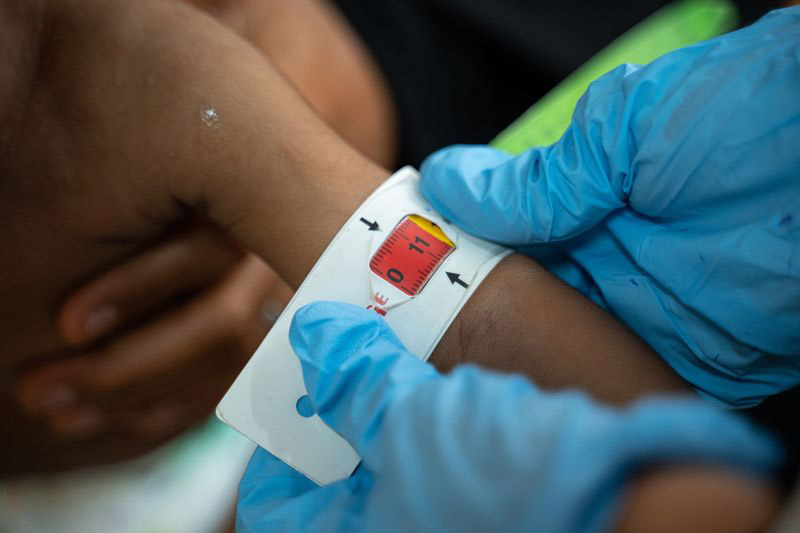 “My child has been frail from the moment he was born, and now his condition is improving, I just wish I could maintain the health of my child,” says Maisa. “I live in constant fear [of] losing him to malnutrition and disease.”
“My child has been frail from the moment he was born, and now his condition is improving, I just wish I could maintain the health of my child,” says Maisa. “I live in constant fear [of] losing him to malnutrition and disease.”
WHO, along with the Central Emergency Response Fund, plays a critical role in supporting 23 TFCs across Yemen, providing essential medical supplies, laboratory supplies and water, sanitation and hygiene supplies, and covering oxygen refilling costs. WHO also supports nearly 395 health workers with performance-based payments to maintain life-saving health and nutrition services. The health workers have gone beyond the provision of life-saving services provision to apply preventive measures too, in the form of both infant and young child feeding counselling, and mental health and psychosocial support.
These 23 TFCs provide all their services free of charge, while consistently meeting the quality standard of life-saving health and nutrition services. This ensures access to life-saving treatment for thousands of children like Hassan. With the WHO support, the centres have so far treated about 8774 severely malnourished children aged under 5 years. Nearly 97% of these children have recovered and been referred to the outpatient therapeutic feeding programme for follow-up.
“I could have lost him if it wasn’t for the free-of-charge treatment here ¬– for that, I’m very grateful for WHO for saving my child,” says Maisa, of Hassan. “I wish that my children remain healthy and have regular meals. Every mother wishes to be able to save her children from agony and turn their suffering into happiness.”
*Note: The beneficiary is in a hard-to-reach location, and was only accessible via phone. The images used are expressive and are not related to the person or location mentioned.
More than 1.29 million children in Yemen protected from polio after door-to-door immunization campaign
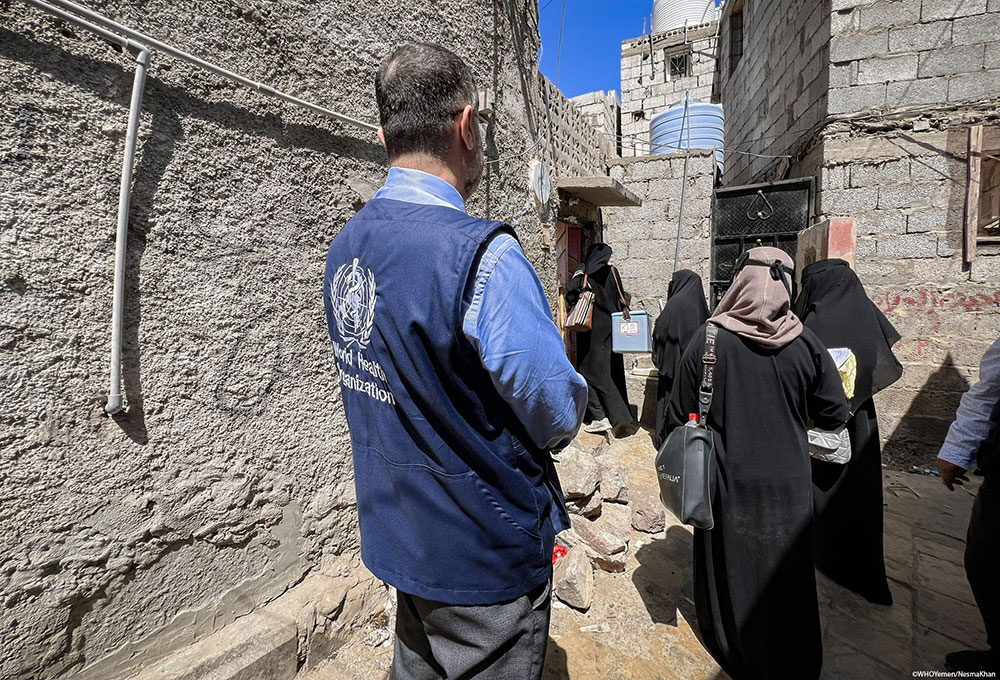 5 March 2024, Aden, Yemen – In just 4 days, a polio immunization campaign in Yemen has reached more than 1.29 million children aged under 5 years. Overall, the campaign achieved 101% coverage, with a range of 89% to over 100%. Yemen’s Ministry of Public Health and Population collaborated with the United Nations Children’s Fund (UNICEF) and the World Health Organization (WHO) to deliver this successful campaign.
5 March 2024, Aden, Yemen – In just 4 days, a polio immunization campaign in Yemen has reached more than 1.29 million children aged under 5 years. Overall, the campaign achieved 101% coverage, with a range of 89% to over 100%. Yemen’s Ministry of Public Health and Population collaborated with the United Nations Children’s Fund (UNICEF) and the World Health Organization (WHO) to deliver this successful campaign.
“This is an important step to protect children from deadly childhood diseases. With confirmed cases of polio among Yemeni children, an imminent threat persists. This is an ongoing risk to the life of every unvaccinated child. Health authorities and donors must continue to work together to ensure universal immunization coverage for all children across Yemen,” said Peter Hawkins, UNICEF Representative in Yemen.
“This is a major achievement in advancing the health outcomes and well-being of children in Yemen. Poliovirus and other childhood diseases can cause permanent disabilities and, in many cases, death. But a small dose of vaccine can provide the necessary protection. There is no reason for children to die of vaccine-preventable diseases. Children are the future, and all investment in their health is an investment in the development of the country,” said Dr Arturo Pesigan, WHO Representative in Yemen.
The campaign was implemented with the generous support of the Global Polio Eradication Initiative. Through this campaign, Yemen joined more than 35 countries in using the novel oral polio vaccine type 2 (nOPV2), which has been granted WHO prequalification. The success of the campaign also resulted from joining forces with health providers who worked hard to reach unvaccinated and zero-dose children to reduce the spread of the disease.
Notes to editors
From 2021 to 2023, Yemen reported 237 variant poliovirus type 2 cases – both circulating vaccine-derived poliovirus type 2 (cVDPV2) and vaccine-derived poliovirus (VDPV). These are known to emerge in contexts of chronic underimmunization. The cases came from 117 districts, and 90% of the affected children were aged under 5 years, while 10% of cases were older children.
Low vaccination coverage and vaccine hesitancy leave children vulnerable to outbreaks of potentially fatal diseases that can easily be prevented. Organized and widespread antivaccination campaigns that misinform the public have also prevented the effective control of disease outbreaks in many communities.
More information
Polio outbreak in Yemen: situation update
Media contacts
WHO Yemen Communications
Email:
UNICEF Yemen Communications
Email:
About WHO
Since 1948, the World Health Organization (WHO) has been the United Nations agency dedicated to advancing health for all, so that everyone, everywhere can attain the highest level of health. WHO leads global efforts to expand universal health coverage, direct and coordinate the world’s responses to health emergencies and connect nations, partners and people to promote health, keep the world safe and serve the vulnerable.
About UNICEF
UNICEF promotes the rights and wellbeing of every child, in everything we do. Together with our partners, we work in 190 countries and territories to translate that commitment into practical action, focusing special effort on reaching the most vulnerable and excluded children, to the benefit of all children, everywhere.
Polio immunization campaign to protect 1.3 million children in 12 governorates of Yemen
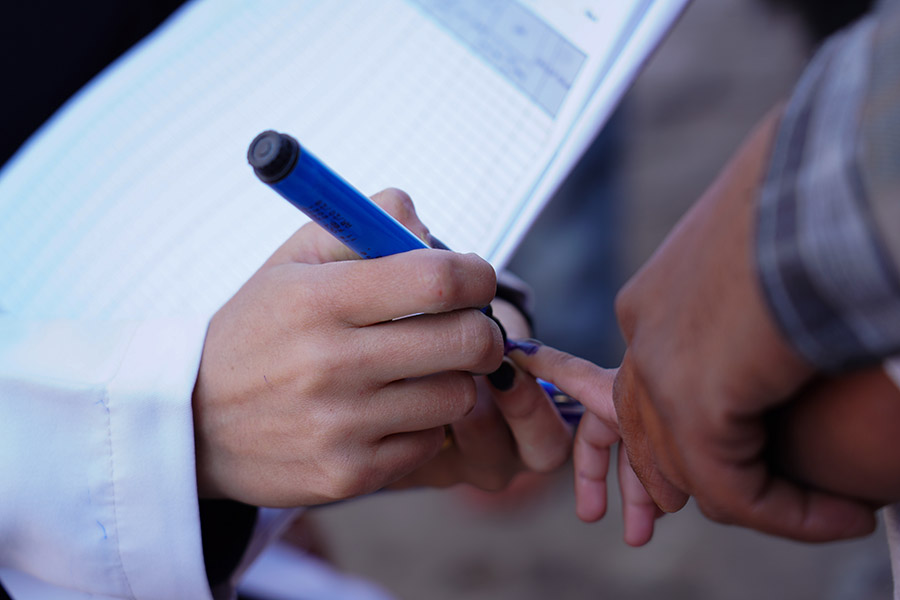 25 February 2024, Aden, Yemen – Around 1.3 million children aged under 5 years will be protected against polio in a vaccination campaign launched today with the support of the Global Polio Eradication Initiative, the United Nations Children’s Fund (UNICEF) and the World Health Organization (WHO). The Ministry of Public Health and Population aims to reach every child and UNICEF and WHO are assisting by providing the vaccine through cold chain storage and providing funding for training and deployment of vaccinators for the campaign targeting 12 governorates in Yemen.
25 February 2024, Aden, Yemen – Around 1.3 million children aged under 5 years will be protected against polio in a vaccination campaign launched today with the support of the Global Polio Eradication Initiative, the United Nations Children’s Fund (UNICEF) and the World Health Organization (WHO). The Ministry of Public Health and Population aims to reach every child and UNICEF and WHO are assisting by providing the vaccine through cold chain storage and providing funding for training and deployment of vaccinators for the campaign targeting 12 governorates in Yemen.
This vaccination campaign is in response to an outbreak of variant poliovirus type 2, which to date has paralysed 237 children across Yemen. Polio infection can result in permanent, debilitating paralysis. It has no known cure but can easily be prevented through vaccination.
“For Yemen’s children, vaccination offers much-needed protection in one of the world’s most challenging contexts. The teams have been working around the clock to train vaccinators and make sure the cold rooms and solar fridges are working and cold boxes are in place to keep the vaccine cold from the moment it arrives in Yemen until it reaches every girl and boy under the age of 5 years,” said UNICEF Representative in Yemen Peter Hawkins.
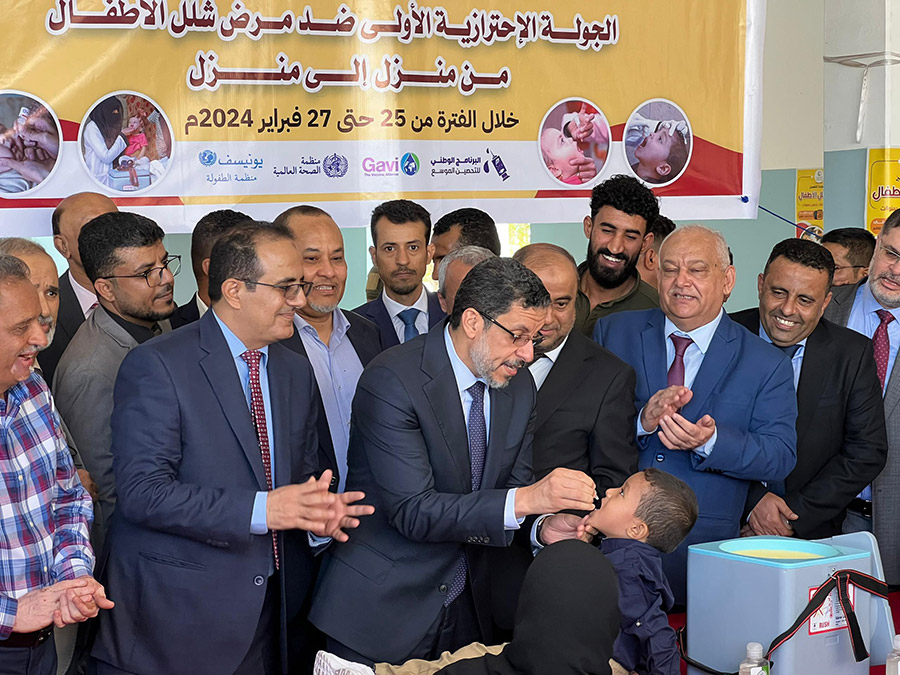 “We know that it is not enough to tell parents why it is important to vaccinate their children. In Yemen, where parents are dealing with conflict, economic crisis and extremely limited public health infrastructure and services, we need to improve access to vaccination. We need to make it easier. In this campaign, we have worked closely with the Ministry of Public Health and Population to ensure the vaccine will be brought to the doorstep of every house in every community in these 12 governorates,” added WHO Representative in Yemen Dr Arturo Pesigan.
“We know that it is not enough to tell parents why it is important to vaccinate their children. In Yemen, where parents are dealing with conflict, economic crisis and extremely limited public health infrastructure and services, we need to improve access to vaccination. We need to make it easier. In this campaign, we have worked closely with the Ministry of Public Health and Population to ensure the vaccine will be brought to the doorstep of every house in every community in these 12 governorates,” added WHO Representative in Yemen Dr Arturo Pesigan.
Mass immunization campaigns aim to boost population immunity in a context of increased risk. This polio campaign comes as children continue to be paralysed, and as testing of wastewater shows the presence of poliovirus in communities. The campaign aims to give girls and boys aged under 5 years an extra boost of protection, on top of their regularly scheduled immunizations and the supplementary immunization campaigns that took place in 2022 and 2023. A second round of the polio vaccination campaign will happen after Ramadan.
The vaccination campaign in Yemen is part of the global effort to eradicate poliovirus, spearheaded by the Global Polio Eradication Initiative.
February 2024 polio vaccination campaign in numbers
3-day campaign: 25, 26 and 27 February
1 290 046 children targeted
120 districts across 12 governorates
5882 mobile vaccination teams
845 vaccination teams working from health facilities
1 billion children globally have already benefited from novel oral polio vaccine type 2 (nOPV2) protection.
Zero cost to parents: vaccination is free.
Media contacts
WHO Yemen Communications
Email:
UNICEF Yemen Communication
Email:
About WHO
Since 1948, the World Health Organization (WHO) has been the United Nations agency dedicated to advancing health for all, so that everyone, everywhere can attain the highest level of health. WHO leads global efforts to expand universal health coverage, direct and coordinate the world’s responses to health emergencies and connect nations, partners, and people to promote health, keep the world safe and serve the vulnerable.
About UNICEF
UNICEF promotes the rights and wellbeing of every child, in everything we do. Together with our partners, we work in 190 countries and territories to translate that commitment into practical action, focusing special effort on reaching the most vulnerable and excluded children, to the benefit of all children, everywhere.
Polio outbreak in Yemen: situation update
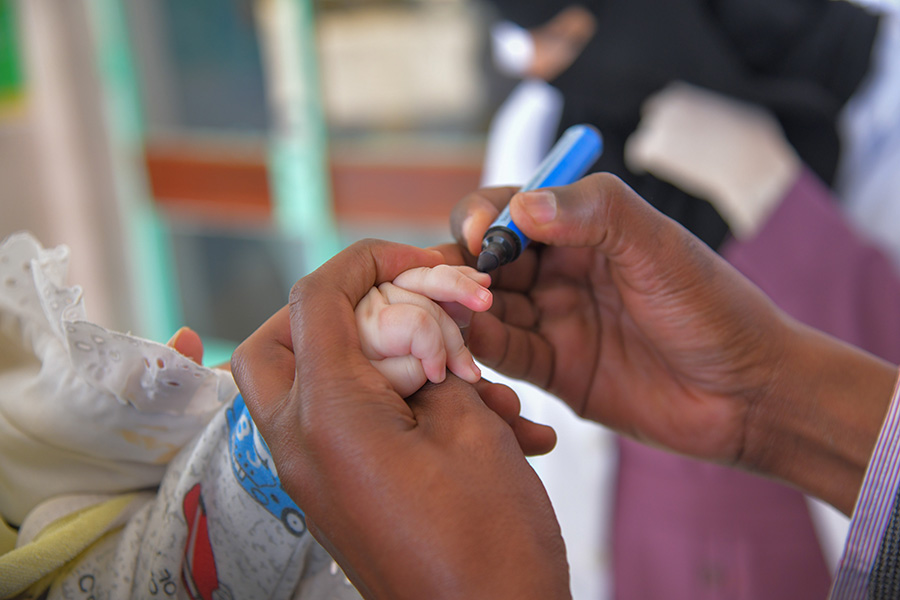 21 February 2024, Aden, Yemen – Conflict could have the worst impact on vulnerable children, who are victims of circumstances beyond their control or capabilities. Almost a decade of conflict has led Yemen to experience devastating outbreaks of vaccine-preventable diseases, which disproportionately affect children. Key contributing factors include extremely limited public health infrastructure and services, limited water availability, and growing levels of vaccine denial and hesitancy.
21 February 2024, Aden, Yemen – Conflict could have the worst impact on vulnerable children, who are victims of circumstances beyond their control or capabilities. Almost a decade of conflict has led Yemen to experience devastating outbreaks of vaccine-preventable diseases, which disproportionately affect children. Key contributing factors include extremely limited public health infrastructure and services, limited water availability, and growing levels of vaccine denial and hesitancy.
“Children are particularly vulnerable to vaccine-preventable diseases such as polio, measles, pertussis and diphtheria,” said Dr Arturo Pesigan, WHO Representative and Head of Mission in Yemen. “One in 4 Yemeni children has not received all the recommended vaccinations on the national routine immunization schedule, and 17% are zero-dose children, who have not had a single dose of diphtheria-tetanus-pertussis vaccine.”
Low vaccination coverage and vaccine hesitancy leave children vulnerable to outbreaks of potentially fatal diseases that can easily be prevented. Organized and widespread antivaccination campaigns that misinform the public have also prevented the effective control of disease outbreaks in many communities.
From 2021 to 2023, Yemen reported 237 variant poliovirus type 2 cases – both circulating vaccine-derived poliovirus type 2 (cVDPV2) and vaccine-derived poliovirus (VDPV). These are known to emerge in contexts of chronic underimmunization. The cases came from 117 districts, and 90% of the affected children were aged under 5 years, while 10% of the cases were among children over 5 years.
Yemen is classified as a country with a high risk of further international spread of cVDPV2. Already, the virus circulating in Yemen has since emerged in Djibouti, Egypt and Somalia.
Fig. 1. Geographic distribution of laboratory-confirmed variant poliovirus type 2 cases (2021–2023)
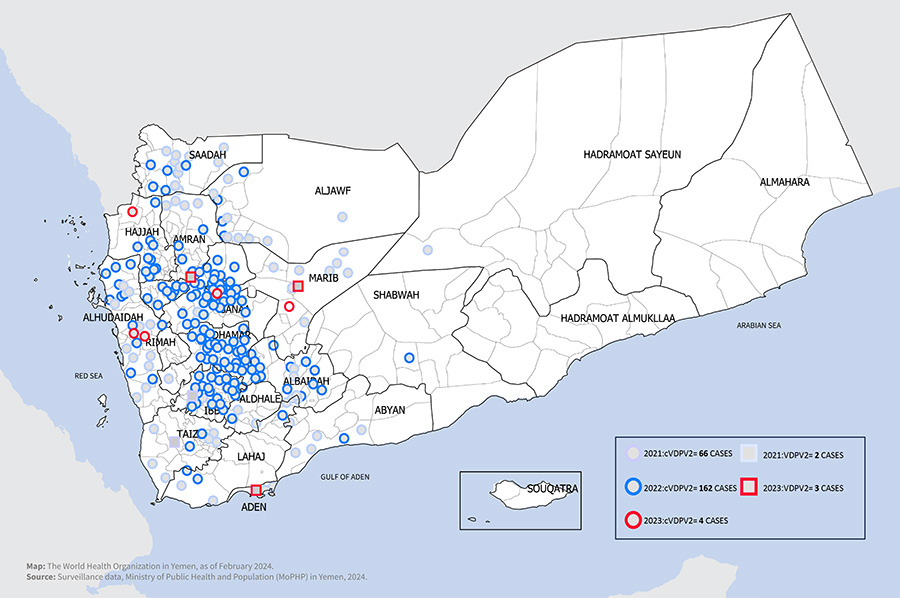 Disclaimer: The boundaries and names shown and the designations used on this map do not imply the expression of any opinion whatsoever on the part of the World Health Organization concerning the legal status of any country, territory, city or area or of its authorities, or concerning the delimitation of its frontiers or boundaries.
Disclaimer: The boundaries and names shown and the designations used on this map do not imply the expression of any opinion whatsoever on the part of the World Health Organization concerning the legal status of any country, territory, city or area or of its authorities, or concerning the delimitation of its frontiers or boundaries.
Fig. 2. Confirmed cVDPV2 cases in Yemen (2021–2023)
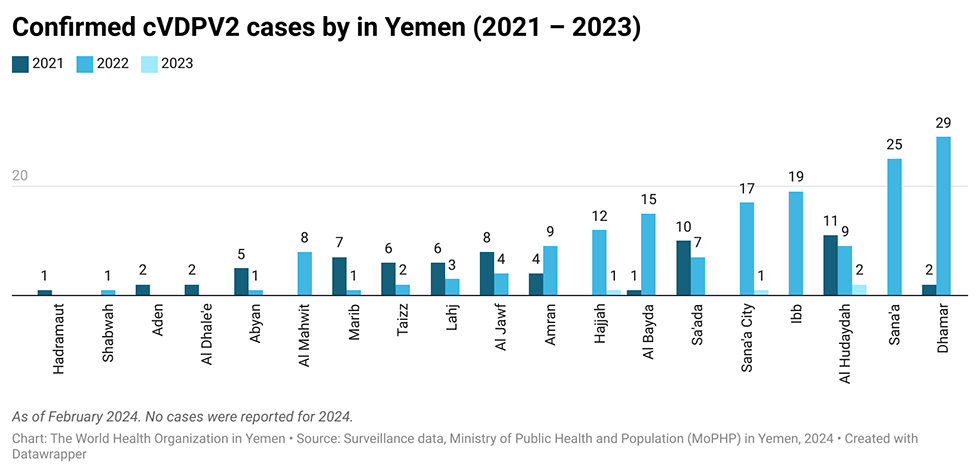
View Fig. 2 in an interactive format
In 2022 and 2023, WHO supported the implementation of 4 vaccination campaigns using trivalent oral polio vaccine (tOPV) in 12 governorates across Yemen. The first and second campaigns targeted about 2.4 million children aged under 10 years; the third and fourth campaigns targeted about 1.2 million children aged under 5 years. In total, 6 925 255 doses of tOPV were delivered through the 4 campaigns. Rising levels of vaccine hesitancy were observed, however, resulting in missed children.
“From 25 to 27 February 2024, Yemen will join countries across the Middle East, Africa and Europe in using novel oral polio vaccine type 2 (nOPV2),” said Dr Pesigan. “The Ministry of Public Health and Population, WHO and other partners are planning a campaign targeting 1 290 000 children from 120 districts in 12 governorates. A total of 6727 teams are deployed: 845 fixed-site teams and 5882 mobile teams.”
More information
Media contacts
WHO Yemen Communications
Email:
About WHO
Since 1948, the World Health Organization (WHO) has been the United Nations agency dedicated to advancing health for all, so that everyone, everywhere can attain the highest level of health. WHO leads global efforts to expand universal health coverage, direct and coordinate the world’s responses to health emergencies and connect nations, partners and people to promote health, keep the world safe and serve the vulnerable.
